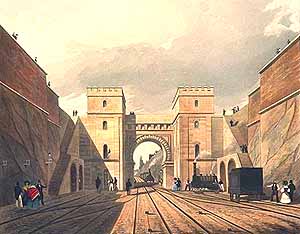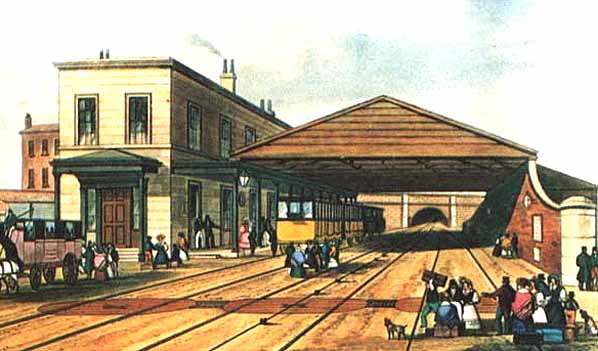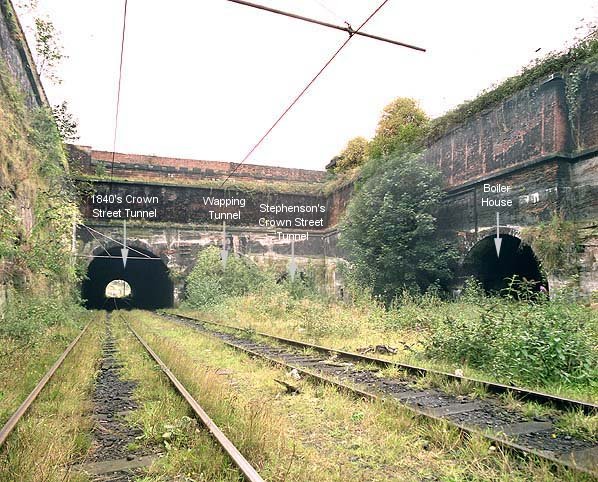Liverpool Lime St
Lime ST NGR SJ353902 Edghill NGR SJ3703900
From 1836 until 1870 trains into Liverpool Lime St were hauled by a stationary steam engine and shunted by horses. There was another cable hauled railway from Crown St station to Edge Hill.
The locomotives would run as far as Edge Hill cutting where they would be detached with loaded coaches being cable hauled through a short tunnel by winding engines at the passenger terminus at Crown Street; returning coaches ran down to Edge Hill by gravity. Goods traffic was handled at the Wapping Goods station close to Liverpool Docks. This was reached by an impressive 2030 metre tunnel from Edge Hill cutting; wagons were cable hauled up from Wapping and descended by gravity
The Crown Street passenger terminus soon proved inadequate due to its size and distance from the city centre and it was closed on 15th August 1836 on the opening of a new terminus at Lime Street, much closer to the city centre. This was reached by a new double track 1006 metre tunnel; although the new line was less steep than Wapping it was still cable hauled. A new engine house was built at Edge Hill, in what is now the station building. Steam for this engine was supplied from a boiler in the old Edge Hill cutting through a long tunnel excavated through the sandstone on the north side of the cutting; this was known as the 'steam tunnel'; the boiler was housed in a chamber cut into the cutting wall. Goods and coal traffic continued to be handled at the old Crown Street station and a second wider tunnel into Crown Street was driven in about 1846. In the 1860's in order to facilitate a new track alignment the Edge Hill cutting w! as widened forcing the demolition of the Moorish Arch.


From 1870, the line into Lime Street was locomotive hauled and a huge chimney with a powered fan was built on Smithdown Lane, near Edge Hill. This was only used for a few years although the chimney lasted until just before WW2. Smoke in the tunnel was always a problem so after a couple of accidents and the need for increased traffic, the two track tunnel was opened up into a deep four track cutting with seven short lengths of tunnel remaining to support various roads and houses. At Edge Hill a further tunnel opened in 1849, north of the Lime Street tunnel. This was another ambitious undertaking comprising two end on tunnels collectively known as Waterloo.
The Waterloo Tunnel at 862 metres is, in reality, the shorter of the two tunnels. Immediately to the west of it is the longer Victoria Tunnel at 2475 metres. The tunnels ran north west to Waterloo Goods Station and the harbour railway system and were, again, cable hauled from Edge Hill.
Cable haulage continued through the Waterloo Tunnel until 1895 when it went over to locomotive haulage and the line was extended to a new passenger station, Riverside, near the pier head, The Wapping Tunnel went over to locomotive haulage the following year. Waterloo Goods Station remained in use until 1963 while Crown Street goods terminal lasted a further five years, closing in 1968; the site was landscaped in 1980.

The Edge Hill cutting is rectangular in shape, bounded on three sides by the vertical walls of the cutting, and at the east by the Chatsworth Street overbridge. North of Chatsworth Street the tracks continue, still in a cutting, to join the main line north of Edge Hill Station.
At the western end three tunnels enter the west wall of the cutting. The northernmost (the 'Stephenson' tunnel) to Crown Street and the central one to Wapping date from the opening of the line while the southernmost tunnel was driven through an original storage recess in about 1846 and was further opened up when the south cutting wall was cut back by three metres after 1864 to accommodate an extra track. Of the three tunnels the Stephenson tunnel is the smallest, being 5.15 metres high to the crown of the arch, and 4.60 metres wide. At the far end, which is now blocked, there is a date stone of 1829 set into the roof. There is also a hole in the floor dropping down into the roof of the Wapping Tunnel. The tunnel is cut through solid rock and unlined with brick arching; internally it is in good condition with a large quantity of long stalactites hanging from the roof.


Many Thanks to Nick Catford for this pictures and info on this page.
www.subbrit.org.uk/sb-sites/index.shtml